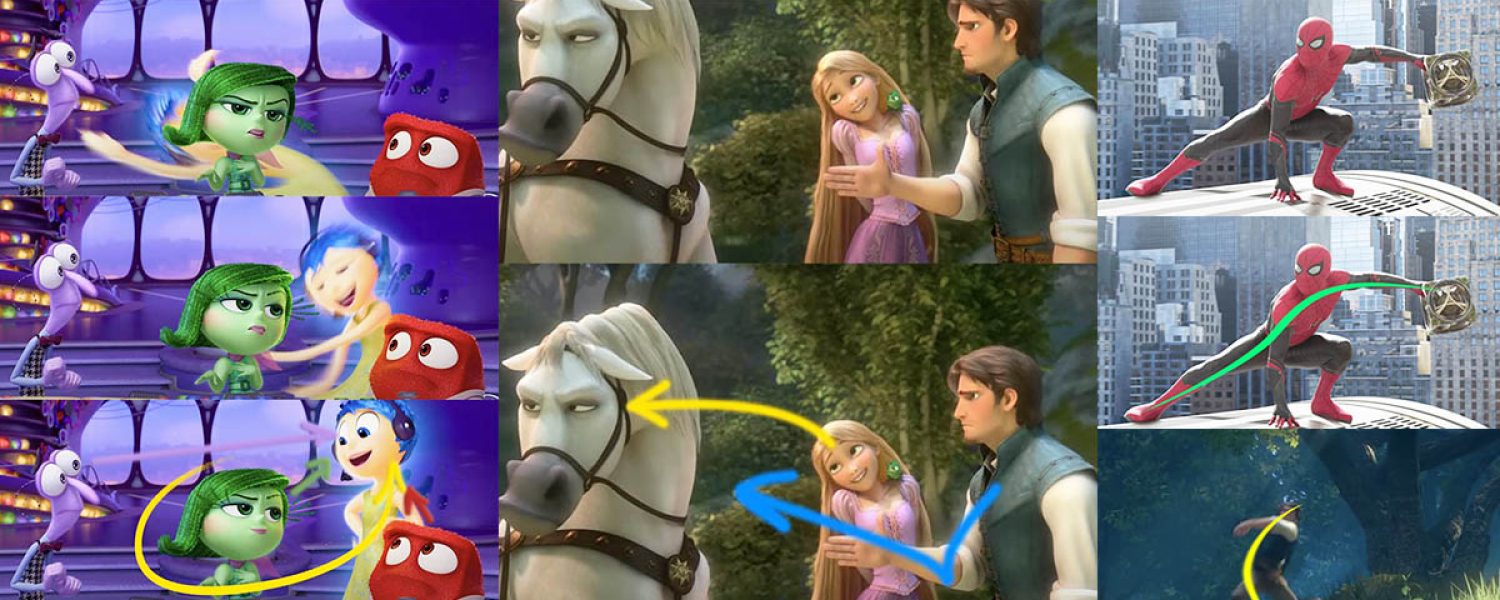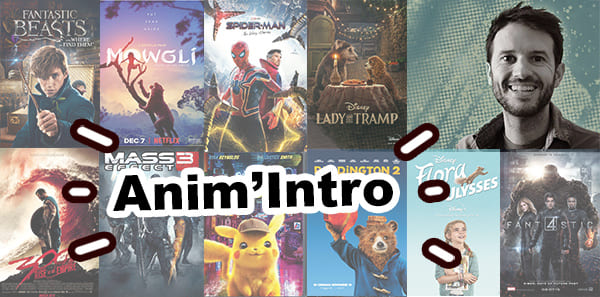What do a Spider-Man comic book, a Tom and Jerry cartoon, and Disney’s Tangled all have in common? Strikingly dynamic poses that are instantly readable and full of energy.
While a clear silhouette plays a major role, there’s another key ingredient behind this visual impact: the line of action.
Hi! I’m Thibault from Animstarter. After 15 amazing years bringing your favorite heroes to life on the big screen, let me share one of my go-to animation secrets with you: the line of action. 🚀
The Invisible Line That Connects Drawing and Animation

In recent 3D animation hits like Moana 2, Inside Out 2, or Flow, this principle is always there—subtle, yet essential. It’s one of the secret ingredients that adds punch, flow, and clarity to movement.
But what exactly is the line of action in drawing or animation?
And why is it so important—whether you’re a character designer, storyboard artist, 2D animator, or 3D animator?
What Is a Line of Action in Drawing and Animation?
The line of action is an imaginary curve that flows through a character’s body.
In just one fluid, expressive stroke, it captures the attitude, intention, and energy of a pose.
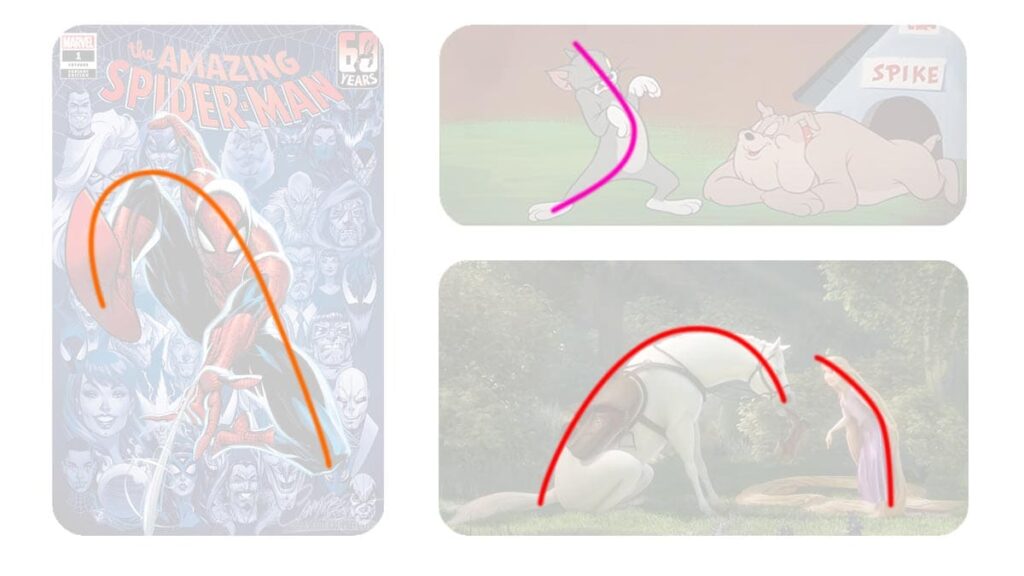
It can be curved, S-shaped, arched, stretched, or full of tension — the shape doesn’t matter, as long as it conveys the energy of the pose.
Every curve you choose instantly communicates to the viewer what the character is feeling or doing. That’s what makes the line of action so powerful.
Why Use a Line of Action in Drawing or Animation?

Force: Dynamic Life Drawing for Animators by Mike Mattesi
1
Dynamism – Making a Static Pose Feel Alive
A pose without a clear line of action often feels stiff, flat, or even unclear.
But a pose built around a strong line of action—even if completely still—appears full of movement. It radiates energy.
It’s like your character is hitting “pause” in the middle of an action, with all the intensity of the moment frozen in their body.

Spiderman No Way Home – 3D Animation
Why is it so crucial? Because movement is born from poses.
Even the smoothest animation starts with poses that have rhythm and meaning. And the line of action is the heartbeat of that pose.
At a single glance, the viewer’s brain should instantly understand what action is taking place.
Is your character about to jump? Then their line of action should first compress, then stretch like a spring.(And if you look closely, you might spot another secret ingredient: curve inversion—but we’ll save that one for later!)
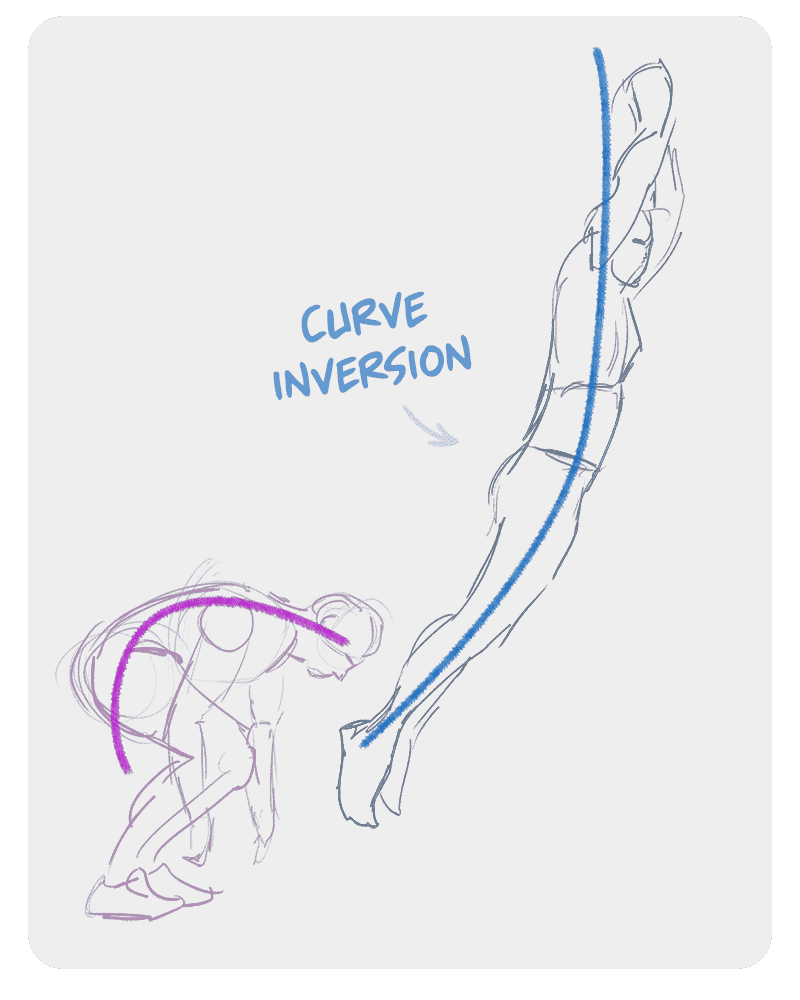
2
Movement – Telling a Story Through Motion
The line of action doesn’t just show what your character is doing — it also shows how. It’s a powerful spatial storytelling tool that helps you:
- Visualize momentum, direction, and the arc of the movement ;
- Anticipate what’s coming next in the action ;
- Create a clear, readable composition in space.
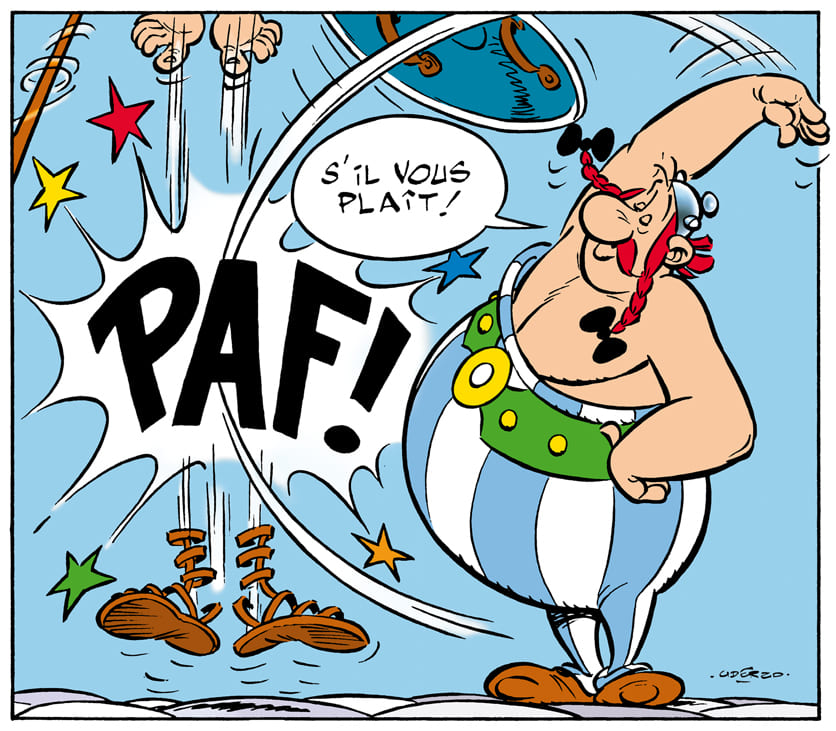
Albert Uderzo – Astérix et Obélix
Let’s take the example of the Asterix and Obelix comics. With just one pose, the reader should understand what happened before, what’s happening now, and what’s about to happen next.
And if you add motion lines that follow the lines of action, you’ve got a winning formula!
This instant readability is essential in comics, where everything relies on visual efficiency: a single panel must convey a clear intention, emotion, and action.
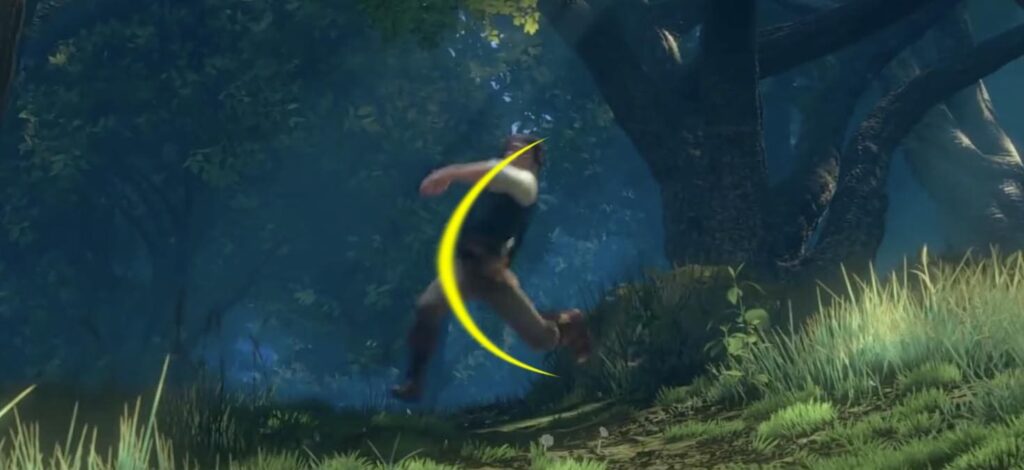
Tangled – Disney
Finally, a well-crafted line of action brings out an intention beyond the simple mechanical gesture. It transforms a technical movement into a meaningful action.
It’s no longer just a character jumping — it’s a character leaping with energy, fleeing, attacking, or playing. In short, a movement full of narrative purpose.
3
Strength – Expressing Tension, Weight, and Effort
The line of action is one of the most powerful tools to suggest physical strength in a static pose. It helps convey muscle tension, resistance, and the energy the body uses to perform a demanding action.
Imagine a character pulling a very heavy object — a wooden crate, a boulder, or a rope tied to something immovable. Their body will lean forward if the object is behind them, or lean backward like in the Tangled example below.

Tangled – Disney
Their entire silhouette becomes one continuous, tense curve that speaks of effort, weight, and resistance.
In this case, the line of action acts like a line of force: it visually connects the points of support (the feet, the ground) to the direction of effort (the arms, the rope, the weight).
The stronger this line is, the more the viewer senses the difficulty of the action, as if the character’s body were elastic, stretched between two opposing forces.
This line makes us feel that the character is struggling against something immovable, that every muscle is engaged, with gravity pulling one way while willpower pushes the other.
The pose becomes expressive and believable—even without animation—the effort is visible, almost tangible.
Even in a simple sketch, a strong line of action can convey thrust, tension, gravity, balance, or loss of balance. It doesn’t just draw a posture—it tells a story of struggle between the body and an external force. This is what gives weight, realism, and above all, physical intensity to an image.
4
The Gaze – Guiding the Viewer’s Eye
One of the great strengths of the line of action—and one of my favorites—is its ability to guide the viewer’s eye.
In an image, our gaze is naturally drawn to lines, curves, and contrasts. The line of action acts like an invisible pointer, a guiding thread that directs how the image is read, often without us even realizing it.
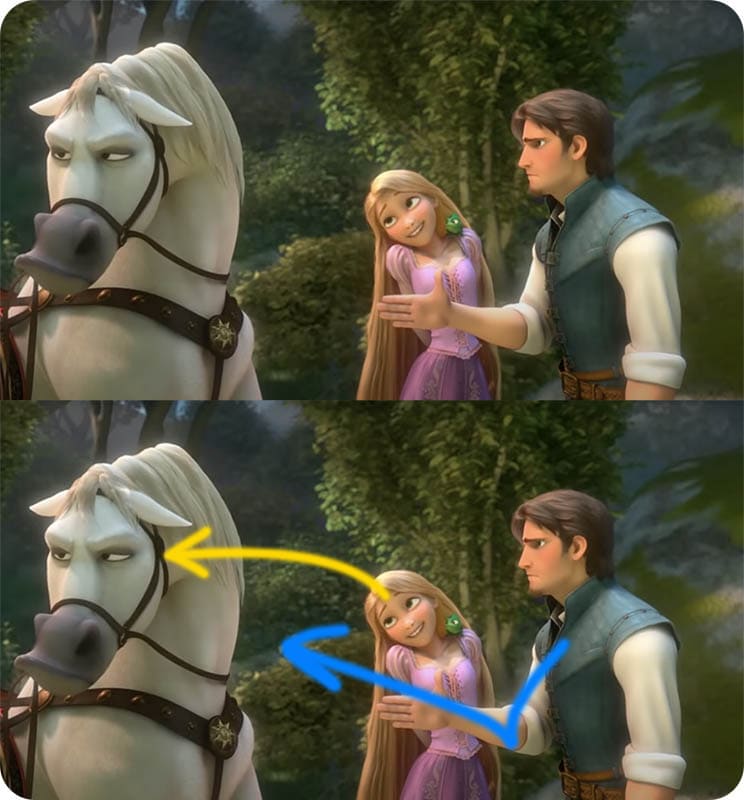
Tangled – Disney
This isn’t about the character’s gaze, but the gaze of the person observing the scene.
By choosing a well-placed and thoughtfully designed line of action, you can subtly guide the viewer’s eye toward an important element: an object, a target, a facial expression, a point of impact, or another character.
For example, here the lines of action of Rapunzel and Flynn’s arm both point toward the horse, Maximus. The viewer is instinctively drawn to look in that direction.
This mechanism works like an organic arrow, integrated into the pose, adding dynamism while ensuring a clear and fluid composition.
It’s also a powerful tool for organizing elements in a complex scene. Instead of a chaotic jumble of visual information, the line of action helps highlight the main subject and creates a clear focal point.
It draws the eye, establishes rhythm, and makes the composition instantly readable—even in a highly animated scene.
In summary, the line of action is not just used to express intention or strength — it tells the story of the image and gives it direction.
When used well, it transforms a static pose into a clear and impactful visual message, where every curve acts as a guide for the viewer’s eye.
5
Fluidity – Creating Smooth and Natural Movement
In 3D animation, the line of action plays a key role in maintaining coherence and continuity of movement. It’s not limited to a single frozen pose—it acts as a guiding thread that connects every stage of an action, from start to finish.
Thanks to it, you can ensure natural transitions between poses, avoid jerky motions, and maintain a smooth visual rhythm. Let’s take a look at this clip from Inside Out 2 below.

Inside Out 2 – Disney
How do you smoothly and gracefully move a character expressing joy from the left to the right of the screen? By exaggerating the line of action to follow the character’s curved trajectory.
It’s like a ribbon flowing through space: it needs to maintain a logical, smooth curve so the eye can follow the movement without disruption.
If the poses are stiff or their lines of action contradict each other, the result feels jerky and mechanical. The viewer may not understand what’s happening or feel uneasy without knowing why.
The line of action helps you think about animation as a whole, not just frame by frame. It encourages designing a harmonious progression and anticipating the curves of movement over time.
It’s a valuable tool to avoid broken poses or poorly oriented joints, and to inject flexibility and clarity into every gesture.
In summary, while the line of action helps create strong poses, it becomes even more powerful when serving as a bridge between those poses—building smooth, natural, and pleasing movement to watch.
In Summary: Why the Line of Action Is Essential
- It’s the foundation of a strong, expressive pose
- It’s used both in drawing and animation (2D or 3D)
- It makes movement smooth, readable, and impactful
- And above all, it gives visual meaning to every gesture
👉 So next time you get stuck, ask yourself: “Where is my line of action?”
Want to explore more?
A big thank you to Zephy for giving me the chance to share my passion with you! If this article inspired you to strengthen your poses, energize your animations, or simply better understand what makes movement impactful… then come check out AnimStarter.com!
You’ll find more practical articles, professional tips, resources, and short films to spark your creativity.
And if you want to put theory into practice, I have a special offer just for you: 🎁 15% off with the code ZEPHY on my discovery session!
It’s a 1.5-hour live video session with me, where I’ll show you behind the scenes of the craft and answer all your questions.
👉 Whether you’re a curious beginner or changing careers, this is a great starting point to really get going!
See you soon,
Thibault

